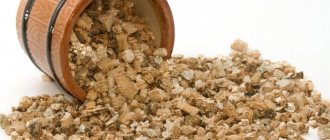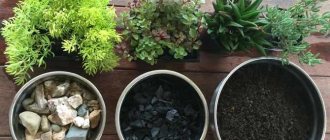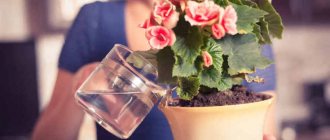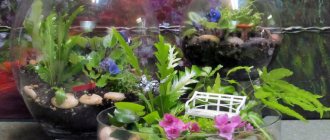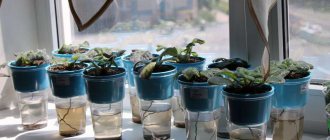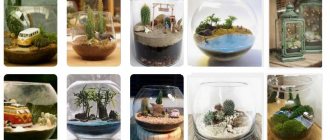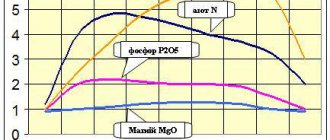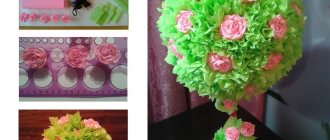What is drainage for indoor plants?
For normal functioning of the root system, indoor plants require soil containing about 50% volume of solid particles, 35% moisture and 15% voids filled with air. These conditions can be ensured only by creating a drainage layer from coarse material.
The absence of air in the soil is favorable conditions for the proliferation of fungi and bacteria, causing rotting of the roots and subsequent oppression of the plant.
Another function of drainage is to ensure rapid drainage of excess water during irrigation. This condition is especially important for plants that cannot tolerate excess moisture.
Drainage materials
What other materials can be used in the process of creating a drainage system? How can you replace drainage for flowers at home? This question often worries flower growers. The information presented below will help you choose the most suitable material to create a drainage layer.
Expanded clay
DIY drip irrigation for indoor plants
Lightweight porous building products are the most popular drainage material that can be purchased at any supermarket. To create a drainage layer, it is recommended to use the middle fraction of foamed and baked clay particles. The size of the average fraction is in the range of 5-20 mm.
The main advantage of expanded clay is the ability to accumulate moisture and the ability to release it as needed. The presence of expanded clay in the soil allows you not to worry about maintaining optimal water balance. In addition, experienced gardeners highlight the following advantages of drainage material:
- low cost;
- small weight;
- long service life.
Note! Expanded clay is endowed with the ability to change the acid-base balance of the soil. This feature can negatively affect the health of flowers.
Agronomists advise covering the soil surface with a small layer of expanded clay in order to eliminate overheating of the earth and prevent excess evaporation. At the same time, it is important not to cover the surface of the earth with a large layer of expanded clay, so as not to disrupt air exchange and not provoke the appearance of mold.
Broken brick
Red brick contains clay. That is why such a material will be an excellent analogue of expanded clay. Most often, finding red brick in a private yard is not difficult. Gardeners often use it to create a drainage system for indoor plants.
Drainage
Ceramic shards
Ceramic shards, along with fragments of dishes, are the most accessible material for creating a drainage system. The main advantages of broken dishes include:
- small mass;
- lack of ability to absorb and retain moisture.
Note! The disadvantage of this material is the presence of sharp corners. You can get injured while working with shards. It is best to carry out the process while wearing thick gloves.
What can be used as drainage at home?
Any coarse material that is chemically neutral, resistant to rotting and destruction, and does not compact over time is suitable for soil drainage.
The following materials have these characteristics:
- natural origin - pebbles and crushed stone;
- specially prepared sterilized expanded clay of the same fraction, vermiculite or perlite;
- improvised materials - pieces of brick, fragments of ceramics and polystyrene foam.
All of the listed materials differ in thermal conductivity, which affects the temperature of the plant root system, the ability to absorb water, and also have other advantages and disadvantages depending on the physical and chemical properties.
Expanded clay for flowers
Expanded clay is a thermally treated clay with a porous structure. Its main purpose is to insulate and soundproof the walls of buildings during construction.
Expanded clay used for drainage first undergoes fractional screening, washed and disinfected. Calibration is also carried out for small, medium and large fractions.
Due to its porosity, expanded clay absorbs excess moisture well and also has high thermal insulation properties, maintaining an optimal temperature for the roots. Within approximately 6 years, this material deteriorates and must be replaced.
Attention! The chemical neutrality of expanded clay is disputed by some florists who claim that it increases soil acidity. However, this material is the most common option for creating a drainage layer.
Ceramic shards
You can use broken ceramic shards to drain the soil. It also has a porous structure, which allows it to accumulate moisture and gradually release it into the ground, preventing the soil from completely drying out. The density of ceramics is higher than that of expanded clay, which results in a longer service life compared to the latter.
The sharp edges of the ceramics must be dulled to prevent mechanical damage to the ends of the plants. Ceramic shards are placed on the bottom of the planting container with the concave side down. Additionally, it is better to sprinkle the top layer of ceramics with expanded clay.
Perlite and vermiculite
Perlite and vermiculite have higher drainage properties. Therefore, these materials are the most expensive.
Perlite is a processed volcanic rock. It is a porous gray or white granule.
Vermiculite is a calcined layered mineral from the hydromica group. During the heating process, the layers are divided into flakes that form pores.
Both perlite and vermiculite are able to absorb water and then return moisture when the soil dries out, and also have excellent thermal insulation properties.
Sphagnum moss
Some florists use sphagnum moss as a drainage layer. It, like a sponge, absorbs a large amount of moisture, preventing the soil in the flower pot from drying out.
Sphagnum is quite rare on sale, but you can prepare it yourself. It is advisable to do this in the autumn, since at this time it is easier to keep the moss in proper condition during transportation. Before use, it is soaked in warm water to saturate it with moisture and remove insects.
Sphagnum moss is stored in a cool place in packaging that provides air access to it. It is also possible to freeze this raw material, since the properties of moss are not lost when defrosted.
Surface expanded clay drainage: installation instructions
It is difficult to overestimate the benefits of using expanded clay in the garden and beds. A universal material that does not rot, does not absorb moisture, is used not only as a drainage base, but also perfectly loosens the soil and saves plants from waterlogging.
Layout and marking of the area for trenches
Surface drainage branches are easy to plan. After the rain, it is worth taking a closer look at the streams of water. The natural direction of flow is the ideal trajectory of the main line. Bends are formed from the central branch at an angle of 45° to the required length.
Surface network: bends - at an angle to the main line
The depth of the trenches is up to 50 cm. The width is up to 60 cm. A sufficient slope is 1 cm for every meter of a straight branch. The slope is formed for both side branches and the main highway. A drainage well is installed at the lowest point.
The walls of the ditch are at an angle to the bottom
Trenches for moisture removal must be of the correct shape: with a flat and solid bottom, and walls at an angle of 30° to the bottom. This form will allow the system to work for decades: moisture will flow smoothly along the inclined surface, without eroding the clay on the walls and without washing out the holes in the bottom.
After completing the excavation work, be sure to check how the canal network copes with the flow of water. Water is supplied from the top point with a hose and the flow speed is assessed. Before laying drainage materials in the trenches, all shortcomings can be corrected by increasing the slope or widening the channel.
How to properly install drainage lines
Surface drainage is arranged without the use of perforated pipes. The channels are left open, without hard covering.
Geotextiles are laid on the bottom on top of the sand cushion, and up to 30 cm of expanded clay is poured. In the garden, it is better to use expanded clay crushed stone (large fraction) - the material does not enter into chemical reactions, does not erode, and cannot be a source of soil contamination.
The expanded clay drainage layer is wrapped with the edges of the canvas. A layer of sand is poured on top. A decorative layer is laid on top of the sand bedding.
Standard expanded clay: an aesthetic material
Standard expanded clay is produced in brown and dark gray colors. You can backfill with standard material, or buy additional gravel - large, oval-shaped expanded clay. For decoration, colored painted material is used: expanded clay retains its color for a long time, and the number of shades will allow you to choose the best option for any landscape design.
Plant protection: removal of surface moisture
Remains of expanded clay after arranging the drainage should not be thrown away. The material will be useful in the vegetable garden and flower beds, in the garden. Around fruit trees you can dig 5-10 centimeter holes with a diameter of up to 1 m. Expanded clay is poured into the hole. This bedding will protect the tree from waterlogging and the occurrence of diseases associated with excess moisture.
Removing excess moisture around plants
The material is also used to loosen and regulate the moisture content of the top fertile soil layer. Expanded clay is mixed with clay. As a result of mulching, the risk of rotting of plant roots is reduced and air circulation in the upper layer of soil is improved.
Video: comprehensive site drainage
Useful material on how to properly arrange the drainage of rain and groundwater, what materials to choose, and in what order to carry out the installation.
Surface drainage can be safely planned and installed independently. Solving the serious problems associated with high groundwater levels requires complex calculations. A specialist must calculate and design the design of the drainage network. To select the type of system, an analysis of the soil composition is carried out and the topography of the site is studied. Only after this they begin to plan the trajectory, the depth of the lines, and select materials. A poorly designed deep network cannot be corrected.
Proper drainage is essential to the health of your plants. Many plant species do not tolerate “wet feet”, i.e. constant immersion in water and die. For most plants, the ideal soil consists of: 15% air, 35% water, and the rest is solids.
When the roots of a plant are immersed in water for more than 1-2 hours, the following happens: the roots suffocate without oxygen and die. When applying fertilizer to a flower pot, excess nutrient solution, if it remains in the pot, increases the acidity of the soil, as a result of which salts will accumulate, the roots will receive a chemical burn and die.
In nature, water falling through precipitation penetrates into the soil, from where it is absorbed by plant roots. Some water is retained by the soil layers. Excess water goes deeper, enters underground streams, and is ultimately either carried out into above-ground reservoirs or accumulated in some underground cavities at great depths.
In a flower pot, everything happens according to the same scenario. Using top or bottom watering, we saturate the earthen ball with water. A small amount of water will be absorbed by the roots, part of it will be retained by the earthen lump. Excess water, under the influence of gravity, rushes to the bottom of the pot.
!!!
Basic rule
.
The flower pot must have a drainage system for excess water !
Typically, one or more holes are made at the bottom of the pot to drain water. Through these same holes, air enters the roots of the plant and the necessary aeration occurs. The holes in the bottom of the pot are called DRAINAGE HOLES.
When choosing a container (pot) for your plant, a drainage hole must be present.
. If you like a pot without a drainage hole:
1st option. Make a drainage hole;
2nd option. You can use a pot without a hole as a decorative container (plant pot) for a pot with holes. It will be much more beautiful than a saucer or tray. After watering the plant, do not forget to drain the water from such a pot (plant pot).
Another important question that constantly worries flower growers is how and from what material to make a drainage layer at the bottom of the pot?
What do many flower growers do?
The bottom of the pot is lined with filter paper, a layer of gravel (foam plastic, broken tiles, expanded clay) is poured to a height of 1-3 cm, then soil substrate is poured onto this layer, into which the plant is planted. These actions are justified by the fact that the specified layer:
a) protects roots from direct, prolonged contact with water;
b) will prevent the roots from forming a plug and closing the hole in the pot.
ALL THESE ACTIONS ARE A BIG MISCONCEPTION AND A WASTE OF TIME AND MONEY.
1st argument.
Firstly, the so-called drainage layer will not be absorbed by the roots of the plant, therefore, it will be wet for a long time. A favorable environment will be created for the development of fungal diseases and the development of pests - primarily fungus gnats (midges), which adore moisture. Secondly, the drainage layer will block the access of air from the drainage hole to the roots of the plant.
2nd argument.
Millions of potted plants are grown industrially every year. You've probably had to buy them at flower shops. You will not find a drainage layer in any pot, and at the same time all the flowers are of excellent quality.
Where is the grain of truth?
And the truth lies in a correctly composed or purchased high-quality soil substrate.
A high-quality substrate should:
Drain the soil well, i.e. When watering, water should quickly penetrate into all corners of the earthen clod, and its excess should drain completely. To do this, components such as sand, perlite, vermiculite, brick chips, etc. are added to the soil mixture.
Maintain its structure for a long time.
In addition, a substrate with the necessary (only for this plant) properties is selected for each type of plant.
How does everything happen in life? The bulk of soil mixtures that are sold in stores and garden centers (Ukraine, Russia) are prepared on the basis of peat (more than 90%). Peat quickly loses its structure; very soon your flower pot will be filled not with structural soil substrate, but with dirt. And no drainage layer compensates for the destruction of the structure of the soil substrate. In addition, many commercial substrates simply do not have drainage components. Again, no drainage layer at the bottom of the pot will compensate for this. They also offer a “Universal Mixture” in stores, which is suitable for all plants. This is generally a lie; soil mixtures with such properties cannot actually exist.
When making a mixture on their own, gardeners use sand as a drainage component, and sand is different from sand. As a soil component, coarse sand (grain size 2-3mm) should be used, and finer-grained sand is almost always used. Fine-grained sand is suitable as a construction filler for mortars, but not as a component of the soil mixture. Sand with fine grains, when watered, is quickly washed out of the earthen clod. The filter paper with which you line the bottom of the pot will retain the sand, but only in bulk, at the bottom of the pot. In this case, the sand will not perform its function.
Conclusions.
- The flower pot in which the plant is located must have a hole.
- 20-30 minutes after watering the plant, be sure to drain the water from the tray (saucer or “pot”).
- To grow a plant, make up the soil mixture correctly (see the soil mixtures section), or buy a high-quality and individually selected mixture.
P.S.
Using drainage in a pot makes sense only in one case - if you have a plant with a weak root system (for example, one of the types of cacti - mammillaria). Under natural conditions, this cactus grows in a small crack in the rock. As a result of evolution, it has formed a small-volume root system, for which a large capacity is not needed and is even harmful.
If you need to plant a plant with an underdeveloped root system, and there is no necessary shallow container, then in order to reduce the volume used for soil, you can fill the excess volume of the pot with drainage.
The health of indoor plants directly depends on the presence of drainage. Many types of flowers simply cannot tolerate the presence of constant moisture in the root system, and some may die from excess moisture.
So most flowers require that the soil composition be 15% air, 35% water and 50% solid particles. That is why it is necessary to provide special drainage, which can help create optimal conditions for the flower.
Excessive watering displaces the 15% of air that plants need so much. In an environment without oxygen, harmful bacteria begin to develop. This contributes to the rotting of the roots and the flower itself withers. Drainage is simply necessary, since this is the only way that excess water can escape and the roots of the plant can breathe.
- what do you know about this?
What climbing plants can be used to cover a gazebo? .
What else can replace drainage? Available means
If it is not possible to purchase industrial-made drainage, you can use improvised materials instead. Suitable for this:
- crushed stone;
- broken brick;
- Styrofoam;
- river stones.
In some respects, the above materials are inferior to industrial ones, however, they are successfully used by florists.
Attention! Use of available raw materials as drainage should be done with caution, because in this way pathogens of fungal and bacterial diseases can be introduced into the soil.
Charcoal
In addition to the function of removing and absorbing excess moisture, charcoal enriches the soil with minerals and disinfects it, preventing rotting, and absorbs salts. It is lightweight and does not affect the weight of flower pots.
Charcoal is placed on the bottom of the planting container in a layer of about 2 cm, and only the coarse fraction is used.
Crushed stone, gravel, river stone
These materials are publicly available, but you need to independently calibrate them in size, filter out debris and pre-rinse them in water. Their disadvantage is their high specific gravity and high thermal conductivity. Therefore, they cause hypothermia of the roots of indoor flowers at low temperatures or overheating when placing pots on window sills above radiators. To improve thermal insulation, it is necessary to lay a layer of expanded clay, perlite or other porous material on top of crushed stone or gravel.
Broken brick
The properties of broken brick are similar to fragments of ceramics. Before using it as drainage, the sharp edges are blunted to prevent damage to the roots. After this procedure, it is washed from dust and debris.
Broken brick is used for plants that store moisture in leaves and stems and are able to do without holes in the bottom of the planting container.
Styrofoam
Polystyrene foam is a lightweight porous material. Moreover, it is public. It removes excess moisture without absorbing water, therefore it is inferior in quality to perlite and expanded clay. However, due to its thermal insulation properties, polystyrene foam maintains the necessary temperature for plant roots.
Attention! It is better to create a drainage layer from polystyrene foam for those indoor plants that require frequent replanting or have an underdeveloped root system. Over time, the roots of the plant grow into the foam, after which it is impossible to free them without mechanical damage.
What should be the drainage?
Many different materials are used for drainage. The main thing is the presence of several required qualities. Drainage should not:
- thicken under the influence of moisture,
- rot from excess water,
- enter into any chemical reactions when wet,
- deteriorate in a humid environment.
And most importantly: it should pass water easily. For this reason, any drainage material consists of fairly large particles that freely allow liquid to pass through.
How to make a drainage layer correctly?
It is better to either completely renew the drainage when replanting plants, or thoroughly rinse it of soil particles when reusing it. The thickness of the drainage layer depends on the type of indoor plant, the height of the pot, and the number and diameter of holes in the bottom of the container.
How to determine how thick the layer should be:
- with a small number of holes in the bottom of the flower pot, a high layer of drainage material is required - up to 1/4 of the height of the pot;
- if the number of drainage holes is larger, it is necessary to make a middle layer of drainage material - 1/5 of the height of the flower pot;
- for pots with a large number of large-diameter holes, a low drainage layer is suitable - 1/6 of the height of the planting container.
Drainage with high thermal conductivity (crushed stone, pebbles, river stones) must be covered with a layer of porous materials - expanded clay, vermiculite or perlite. The size of the drainage material should be smaller in diameter than the holes in the bottom of the flower pot and cover the bottom evenly.
Why are drainage holes needed in a flower pot?
In addition to proper drainage, it is important to find a good pot for planting. When purchasing a container, pay attention to whether it has drainage holes, what size they are and how they are located. If the holes are too small, the moisture will drain slowly, if they are large, the moisture will drain quickly. If there are no holes at all, they can be made at home using a drill with a suitable drill diameter.
To ensure the correct soil moisture for certain indoor plants, you should choose a container with the correct holes:
- For succulents, cacti and some types of orchids, moisture must drain quickly. A small pot with porous soil and small holes is suitable for them.
- For plants growing in high humidity, it is better to select containers with dense soil and a minimum of small holes.
Drainage holes in flower pots
Mistakes when making your own
Florists make the following mistakes when making drainage:
- Using sand, which compacts and does not allow moisture to pass through.
- The fraction of drainage material is over 3 cm, which does not retain moisture.
- The use of organic materials that rot over time.
- Use of chemically unstable materials.
- Laying drainage with sharp edges that damage the roots of indoor plants.
The healthy appearance of the plant, growth and development depend on the condition of the soil and drainage layer. Properly laid drainage will provide the required humidity for a particular type of indoor plant.
5/5 — (2 votes)
Deep drainage with expanded clay sprinkling
The main purpose of installing deep drainage is to reduce the groundwater level. Level adjustment is not required in all areas. Deep drains must be installed:
- With a strong deepening of the foundation.
- If the house is built on a slope.
- The soil is oversaturated with moisture, and the groundwater level does not decrease during drought periods.
Mandatory zones for laying a drainage network: around the foundation with an indentation of several meters, in the center of an area located on a slope, with branches diverted to the sides. It is better to entrust depth calculations to specialists: at each site, the installation depth is calculated individually.
When organizing drainage around the foundation, the depth should be below the permanent groundwater level. Indentation - up to 8 meters from the walls, minimum - 4 m. It is advisable to deepen the trenches below the freezing point
Minimum depth values for different zones:
- In a garden with fruit trees, the depth of drainage is up to 1 m.
- On the lawn and in the vegetable garden, it is enough to deepen the drainage to 70 cm.
Depth line in section: diagram
The width of the trenches is 50–60 cm. The slope of the channel is from 1 to 3 cm per meter of line. A ring is created around the house, closed in a drainage well. The highest point is selected, and lines are dug from it at an angle. The lowest point is at the connection point (drainage well).
Frost-resistant sprinkling: rules for constructing trench clips
The bottom of the dug trenches is compacted. Make a sand cushion up to 15 cm high. After compaction, be sure to check the level of the slope.
Geotextiles are laid on the sand. The canvases are spread in the center of the trench so that the edges remain free. For convenience when laying inside the channel, the free edges are fixed to the walls.
Drainage clip with expanded clay
A layer of expanded clay crushed stone is poured onto the fabric - the thickness of the drainage layer is up to 60 cm. Backfilling is carried out in 2 ways:
- Pour out the entire volume at once.
- Half of the planned height is poured, and after installing the pipe - the second half.
Pipe covered with expanded clay
Pipes are laid inside the backfill. The sections are connected with special couplings. Expanded clay is leveled around the pipe so that the thickness of the bulk material is the same on all sides. The edges of the textile are overlapped at the top. For fixation use adhesive tape.
The finished clip is covered with a dense layer of sand. The top is backfilled with soil.
Using expanded clay for flower drainage
Expanded clay is baked clay with a porous structure; it can be purchased at all flower shops.
Expanded clay is also used in construction as insulation and soundproofing material. The medium and small fractions are often used in floriculture.
For large plants, expanded clay of the middle fraction is selected - up to 2 cm in diameter. A layer of sand is poured on top.
The shelf life is 5-6 years, after which it turns into soil, so it needs to be changed periodically.
The main advantage is not only the removal of excess moisture, but also the absorption of it.
Behind it are detailed instructions.
What is the use of horizontal cotoneaster on the site? .
Description of Variegated Derain - how to plant, care, prune -
